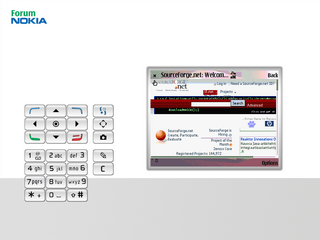With SXSW Interactive 2007 winding down I’ve started reflecting on SXSW from a mobile perspective. First of all I found myself using sxsw.mobi from my phone quite a bit in the beginning of the conference as it allowed me the same overview that the pocket schedule did but also allowed me to drill down in to panel details. As I had more time to research my panel selection later in the week I found myself using my annotated (analog) pocket guide more and the mobile site less.
One of the most invigorating sessions was Brian Fling’s presentation entitled Everything you wanted to know about the mobile web (but were afraid to ask). His slide deck is chock-full of information but only as much jargon as absolutely necessary. There wasn’t a lot of new information in it for me, but I think he’s doing exactly the right thing by firing up this group of alpha designers about mobile design and showing them that it’s not that hard. In fact XHTML-MP is still just XHTML and while there are lots of limitations, CSS is still CSS. He also mentioned several great resources in his presentation including the brand new .mobi mobile web developer’s guide. Also worth reading is the Mobile Web Initiative’s Mobile Best Practices document.
I also caught a mobile panel on Monday called “Mobile Application Design Challenges and Tips.” Dan Saffer took some great notes on the panel which focused on the trials and tribulations experienced when developing a mobile app. It was nice to hear that several apps were quite successful operating “off-deck” or outside of carrier portals. It was great to hear Matt Jones talk about lower level UI bits and revel in the success of ZoneTag, but my biggest takeaway from the panel was from John Poisson of radar.net. His advice was to not worry too much about details. Get it out there as quickly as you can, even if it’s simpler than you plan for it to be. Gather feedback from your users and continue to improve the product. This also seemed to jive with my takeaway from the turning projects in to revenue panel: fail early, fail often.
The other mobile panel that stood out was called There’s no Such Thing as the Mobile Web (Or Is There?) I found a great set of notes on this panel at Eran’s blog. The panel started off discussing if there was a seperate “mobile web” or not and in the end it was hard to come up with a solid answer. It is significant to note that what a user does or expects to do on a mobile device is somewhat different than what a person needs when sitting in front of a computer. Context, location, creating content and retrieving information quickly are essential. It was interesting to get several different viewpoints on the issue: Dan Applequist from the standards and carrier viewpoint, Carlo from the industry analyst side, Michael Sippey from the blogging/content creation point of view, and Dwipal Desai who is focusing on mobile for a little company called YouTube. I was fascinated at how well Six Apart know their users: They focus on richer apps on higher end devices for a service like Vox but emphasize text messaging for LiveJournal because those users tend to be younger with cheaper phones, limited data capability, but usually have unlimited messaging plans. Vodafone are also in a unique position to offer a rich environment with asynchronus communication built around SVGT. Looking forward it’s obvious that there’s a ton of potential for the mobile web (or connected rich applications, or whatever you’d like to call it) but it’s unclear exactly which path we’ll take and what it will be.
I truly hope that the topics discussed at SXSW this year will encourage these alpha designers, UI experts, and coders to take a closer look at mobile apps and push the limits of the mobile web.





